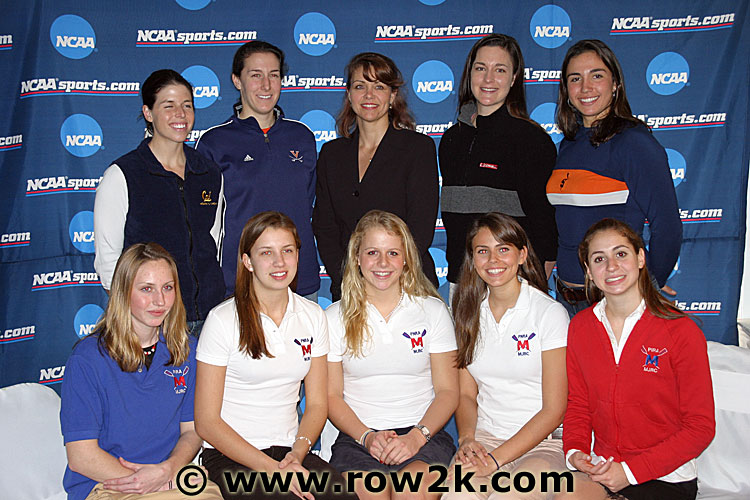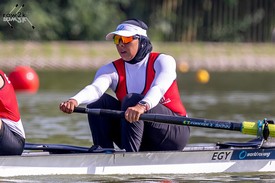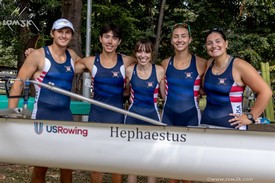row2k Features
Tenth NCAA Women's Champs


PNRA Athletes and Worthington
The recently renamed Princeton National Rowing Association (formerly the Princeton International Regatta Association) held a double debut lunch yesterday; the official announcement of Mercer Lake as the site of the 2006 NCAA Women's Rowing Championships May 26-28 coincided also with PNRA executive director Kay Worthington's first public appearance in her new position.
The Finn M.W. Caspersen Olympic Rowing Training Site on Mercer Lake will be the site of the 2006 Division I, II and III NCAA Women’s Rowing Championships, May 26 through 28. Princeton National Rowing Association (PNRA) will host the three-day regatta at their facility with Rutgers University serving as the host institution.
Worthington was joined by several local officials at the event, along with a cross-section of the folks who regularly use the lake, including national team rowers from the training center, senior athletes from the Mercer junior program, and local coaches, including Rutgers women's coach Max Borghard as representative of the host institution.
The 2006 event will mark the 10th anniversary of the women's NCAA championships; Worthington noted that the 2006 championships will mark only the second time it has been held on the east coast. Previous host sites for the event include Cooper River in Camden NJ, Lake Lanier in Gainesville GA, Indianapolis, IN, and most recently, Rancho Cordova, CA, where the championships were held the past two years. "We are looking forward to working with Rutgers staff to showcase our facility and offer the best championships yet," she said.
The occasion of the tenth anniversary inspired speakers to look back at the changes in women's rowing since the inception of the championships.
Megan Dirkmaat, a former Cal rower and current National team athlete and Mercer junior coach, remembered the impact the first championship had on the Cal program back when she was a frosh at Cal in 1997.
"When I first heard about the championship, we had about 10 girls rowing, and only a few of them really took it seriously," the 2000 Cal grad recalled. "Then they hired a new coach, we had this championship, and over time the program went from our Podunk group into a solid team that went on to win the championship last year." Dirkmaat also noted the rising standard of athlete coming up to the national team. "The NCAA's really boosted the level of rowing in the country, so I am never comfortable with my seat on the National Team. I'm always trying to stay ahead, wondering who the next new kid will be."
As a Mercer junior coach, Dirkmaat looks forward to the exposure her charges will have in May. "This is a great opportunity for the kids here, to see what they have to look forward to as college athletes, and even beyond."
The kickoff of the junior rowing program was a classic example of pent-up demand, and clear evidence to many who believe that rowing is growing if we just give it a chance. In response to the routine round of announcements at schools and on post office bulletin boards, nearly 300 kids showed up for the first organization meeting a couple years ago. Two Mercer athletes, Rebecca Fein and Erin Conlon, spoke to the same notion.
Fein, a senior coxswain who attends Princeton Day School, said that before she joined the rowing program, "I was incredibly bored, hanging out with people who enjoyed finger-painting to pass the time." She found rowing, and became the first-boat coxswain, team captain, and is headed to Brown next fall. Conlon, a senior rower, said she credited her rowing with her prospects for "getting a great education and the possibility of competing and the national level in college and beyond."
(Fein also mentioned that she went from finger-painting to "checking rowing Web sites every night before I start my homework;" row2k is just glad to hear that she is going to a great school, as we do our best to make row2k interesting, but sure don't want to keep anyone from more important daily rounds!)
Princeton coach Lori Dauphiny conjured memories of the pre-NCAA championships. "There was great racing, but the race was mostly organized by the coaches, and whether or not crews could attend depended on whether they had the funding, whether athletes could stay on after school was finished, and other factors. We often had the best crews in the country, but there was no guarantee, and there were usually only eight or nine crews attending. Now the championship is funded, with 16 teams and at-large eights, and it is certain that absolutely the fastest boats will race for the national championship."
Dauphiny also noted the impact NCAA status has had on women's rowing from high school to the Olympic level. "For women's rowing, it has created enormous opportunity, and you see it at all levels, especially at the high school level. Where we previously talked to a few dozen high school rowers each year, we may talk to 300 now." A national team and Olympic coach, Dauphiny added that "at the national level, we see women who have rowed at a much higher level, often at this very championship."
On having the championships almost in Princeton's backyard, Dauphiny was cautiously optimistic. "It's only three miles from our boathouse to this lake, which will be great, but I don't want to jinx us, as we haven't qualified yet!" She added that "the 2004 Olympic team was selected on this body of water, all the NSRs and trials are held here, and the people here have the credentials to run a fabulous NCAA championship."
T the NCAA championships are just one piece of a very busy 2006 at Mercer Lake this year, with the usual battery of speed orders, NSRs, trials, high school races, and "neutral location" collegiate duals augmented by yet another major event, the FISA World Masters in September. Local officials were also in attendance at the lunch, including West Windsor mayor Shing-Fu Hsueh (Mercer Lake is located in West Windsor township), and New Jersey Assemblywoman Linda Greenstein, who said "I'm very excited; this is wonderful for our area. I wish I had rowed when I was your age!"
Local impact can be considerable; Division I includes 312 competitors and three events - varsity eights, junior varsity eights and fours. Division II, the smallest of the three divisions, has a total of 68 competitors and two events, varsity eights and fours. The Division III championship includes a total of 108 competitors in one event where both varsity and junior varsity eights to compete together.
Here's to a great 2006 championship; attendees arrived at the event in a torrential downpour accompanied by howling winds; after the obligatory light lunch and photo opps, folks went to walk out the door just as the sun blasted through the clouds; take it as a good sign.
The Finn M.W. Caspersen Olympic Rowing Training Site on Mercer Lake will be the site of the 2006 Division I, II and III NCAA Women’s Rowing Championships, May 26 through 28. Princeton National Rowing Association (PNRA) will host the three-day regatta at their facility with Rutgers University serving as the host institution.
Worthington was joined by several local officials at the event, along with a cross-section of the folks who regularly use the lake, including national team rowers from the training center, senior athletes from the Mercer junior program, and local coaches, including Rutgers women's coach Max Borghard as representative of the host institution.
The 2006 event will mark the 10th anniversary of the women's NCAA championships; Worthington noted that the 2006 championships will mark only the second time it has been held on the east coast. Previous host sites for the event include Cooper River in Camden NJ, Lake Lanier in Gainesville GA, Indianapolis, IN, and most recently, Rancho Cordova, CA, where the championships were held the past two years. "We are looking forward to working with Rutgers staff to showcase our facility and offer the best championships yet," she said.
The occasion of the tenth anniversary inspired speakers to look back at the changes in women's rowing since the inception of the championships.
Megan Dirkmaat, a former Cal rower and current National team athlete and Mercer junior coach, remembered the impact the first championship had on the Cal program back when she was a frosh at Cal in 1997.
"When I first heard about the championship, we had about 10 girls rowing, and only a few of them really took it seriously," the 2000 Cal grad recalled. "Then they hired a new coach, we had this championship, and over time the program went from our Podunk group into a solid team that went on to win the championship last year." Dirkmaat also noted the rising standard of athlete coming up to the national team. "The NCAA's really boosted the level of rowing in the country, so I am never comfortable with my seat on the National Team. I'm always trying to stay ahead, wondering who the next new kid will be."
As a Mercer junior coach, Dirkmaat looks forward to the exposure her charges will have in May. "This is a great opportunity for the kids here, to see what they have to look forward to as college athletes, and even beyond."
The kickoff of the junior rowing program was a classic example of pent-up demand, and clear evidence to many who believe that rowing is growing if we just give it a chance. In response to the routine round of announcements at schools and on post office bulletin boards, nearly 300 kids showed up for the first organization meeting a couple years ago. Two Mercer athletes, Rebecca Fein and Erin Conlon, spoke to the same notion.
Fein, a senior coxswain who attends Princeton Day School, said that before she joined the rowing program, "I was incredibly bored, hanging out with people who enjoyed finger-painting to pass the time." She found rowing, and became the first-boat coxswain, team captain, and is headed to Brown next fall. Conlon, a senior rower, said she credited her rowing with her prospects for "getting a great education and the possibility of competing and the national level in college and beyond."
(Fein also mentioned that she went from finger-painting to "checking rowing Web sites every night before I start my homework;" row2k is just glad to hear that she is going to a great school, as we do our best to make row2k interesting, but sure don't want to keep anyone from more important daily rounds!)
Princeton coach Lori Dauphiny conjured memories of the pre-NCAA championships. "There was great racing, but the race was mostly organized by the coaches, and whether or not crews could attend depended on whether they had the funding, whether athletes could stay on after school was finished, and other factors. We often had the best crews in the country, but there was no guarantee, and there were usually only eight or nine crews attending. Now the championship is funded, with 16 teams and at-large eights, and it is certain that absolutely the fastest boats will race for the national championship."
Dauphiny also noted the impact NCAA status has had on women's rowing from high school to the Olympic level. "For women's rowing, it has created enormous opportunity, and you see it at all levels, especially at the high school level. Where we previously talked to a few dozen high school rowers each year, we may talk to 300 now." A national team and Olympic coach, Dauphiny added that "at the national level, we see women who have rowed at a much higher level, often at this very championship."
On having the championships almost in Princeton's backyard, Dauphiny was cautiously optimistic. "It's only three miles from our boathouse to this lake, which will be great, but I don't want to jinx us, as we haven't qualified yet!" She added that "the 2004 Olympic team was selected on this body of water, all the NSRs and trials are held here, and the people here have the credentials to run a fabulous NCAA championship."
T the NCAA championships are just one piece of a very busy 2006 at Mercer Lake this year, with the usual battery of speed orders, NSRs, trials, high school races, and "neutral location" collegiate duals augmented by yet another major event, the FISA World Masters in September. Local officials were also in attendance at the lunch, including West Windsor mayor Shing-Fu Hsueh (Mercer Lake is located in West Windsor township), and New Jersey Assemblywoman Linda Greenstein, who said "I'm very excited; this is wonderful for our area. I wish I had rowed when I was your age!"
Local impact can be considerable; Division I includes 312 competitors and three events - varsity eights, junior varsity eights and fours. Division II, the smallest of the three divisions, has a total of 68 competitors and two events, varsity eights and fours. The Division III championship includes a total of 108 competitors in one event where both varsity and junior varsity eights to compete together.
Here's to a great 2006 championship; attendees arrived at the event in a torrential downpour accompanied by howling winds; after the obligatory light lunch and photo opps, folks went to walk out the door just as the sun blasted through the clouds; take it as a good sign.
SUPPORT ROW2K
If you enjoy and rely on row2k, we need your help to be able to keep doing all this. Though row2k sometimes looks like a big, outside-funded operation, it mainly runs on enthusiasm and grit. Help us keep it coming, thank you! Learn more.
If you enjoy and rely on row2k, we need your help to be able to keep doing all this. Though row2k sometimes looks like a big, outside-funded operation, it mainly runs on enthusiasm and grit. Help us keep it coming, thank you! Learn more.
Rowing Features
In the Driver's Seat, with Lizzie Johnston
April 16, 2024
This Week's Best of Rowing on Instagram 4/13/2024
April 13, 2024
In the Driver's Seat, with Athena Santana
April 9, 2024
Wisconsin's Tassneem Arafa
April 3, 2024
US Para Team's Collegians
April 1, 2024
This Week's Best of Rowing on Instagram 3/30/2024
March 30, 2024
Rowing Headlines
2024 Inaugural CRCA Athletes to Watch
March 13, 2024
World Rowing suspends Serbian Rowing Federation over financial debts
January 23, 2024
National Rowing Hall of Fame ® Class of 2023 Announced
October 5, 2023
Advertiser Index
- Bont Rowing
- Calm Waters Rowing
- Concept 2
- Craftsbury Sculling
- The Crew Classic
- CrewLAB
- Croker
- Durham Boat Co.
- Empacher
- Faster Masters
- Filippi
- Fluidesign
- h2row.net
- HUDSON
- Live2Row Studios
- Nielsen-Kellerman
- Oak Ridge RA
- Peinert Boat Works
- Pocock Racing Shells
- Race1 USA
- RowKraft
- Rubini Jewelers
- Vespoli USA
- WinTech Racing
Get Social with row2k!
Get our Newsletter!
Enter your email address to receive our weekly newsletter.
Support row2k!
Advertiser Index
- Bont Rowing
- Calm Waters Rowing
- Concept 2
- Craftsbury Sculling
- The Crew Classic
- CrewLAB
- Croker
- Durham Boat Co.
- Empacher
- Faster Masters
- Filippi
- Fluidesign
- h2row.net
- HUDSON
- Live2Row Studios
- Nielsen-Kellerman
- Oak Ridge RA
- Peinert Boat Works
- Pocock Racing Shells
- Race1 USA
- RowKraft
- Rubini Jewelers
- Vespoli USA
- WinTech Racing

















